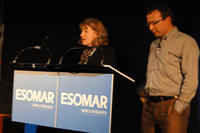Andrew Needham, Face UK, took over stewardship of the early afternoon session, promising that no-one would be interested in a post-lunch nap given the presentations he was about to introduce!

First up was Aruni Ghosh, Nielsen UAE, who – along with Maneesh Kaushik, Pepsico MEA – demonstrated the influence of culture in shopping attitudes & behaviours…..using Hofstede’s 6 cultural elements, Aruni put forward three compelling shopper arguments…
(a) that shoppers are first and foremost people, so we must be aware of their “bigger picture” (the macro forces that Tom referred to earlier!),
(b) Traditional market clusters may be convenient, but we must exercise caution with their application, if there is no cultural understanding, and
(c) the key challenge is now how to break habitual behavior(s), which is what the bulk of segments still rely on.
A thought-provoking session, succinctly echoed by Maneesh, when he said that based on cultural patterns and known volume movements, there are some common retail challenges in China and Saudi Arabia.
Aruni was then followed by Debra Walmsley & Stephen Barr, of Leapfrog Research and Persuasion Engines respectively, who demonstrated the benefits of overlaying research insights onto targeting models.

Entitled “Headroom vs Heartroom”, their presentation clearly showed that consumers are far more interested in ROE – ‘Return on Engagement’ – than ROI – ‘Return on Investment’ – a particularly persuasive argument when they showed the very interesting example of Boden, an on-line retailer.
The last presentation of this early afternoon session was a demonstration of how on-line communities can help brands stay in touch with their shoppers decision making processes.

Presented by Beth Corte-Real, Coca-Cola NW Europe and Philip McNaughton of Face UK, their story was driven by the challenge of how to bridge the gap between brand “love”and actual volume sales. The approach they described provided answers to such key questions as: How do we deal with the complexity and blurring between shopper providers and shopper consumers? How do we capture the 24/7 shopping experiences? And..How do we capture real-time shopper behavior and thus close the gap between what shoppers say they do, and what they actually do?
Real food for thought………


